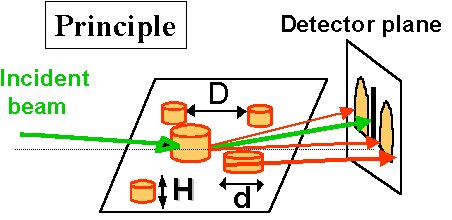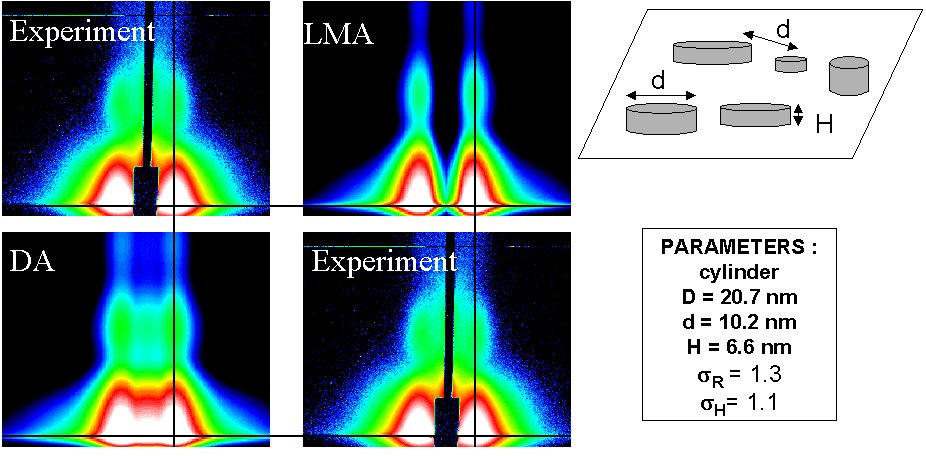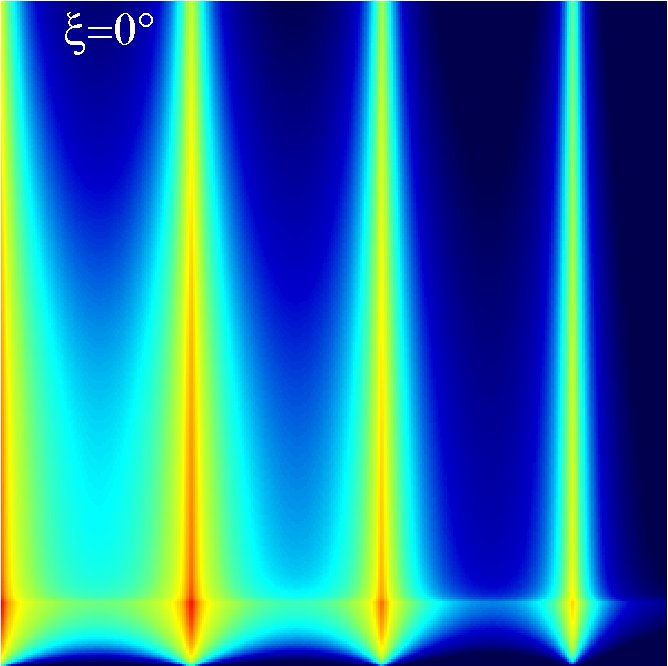IsGISAXS
a program for analyzing Grazing Incidence Small Angle X-Ray Scattering from nanostructures
by
Rémi Lazzari
Institut des NanoSciences de Paris,
Universités Pierre et Marie Curie et Denis Diderot
CNRS UMR 7588
Paris, FRANCE
 |
New release : IsGISAXS 2.6 ! |
Introduction |
IsGISAXS is a software dedicated to the simulation and analysis of Grazing Incidence Small Angle X-Ray Scattering (GISAXS) from nanostructures. The lack of analysis program in this rapid growing field has motivated the development of such a tool. The theoretical treatment needs to combine some notions of "classical" small-angle scattering and diffraction in 2D with the specificity of grazing incidence. IsGISAXS only encompasses the scattering by nanometric sized particles which are buried in a matrix subsurface or supported on a substrate or buried in a thin layer on a substrate. The case of holes is also handled. The geometry is restricted to a plane of particles. The scattering cross section is decomposed in terms of interference function and particle form factor. The emphasis is put on the grazing incidence geometry which induces a "beam refraction effect". The particle form factor is calculated within the Distorted Wave Born Approximation (DWBA), starting as an unperturbed state with sharp interfaces or with the actual perpendicular profile of refraction index. Various kinds of simple geometrical shapes are available with a full account of size and shape distributions in the Decoupling Approximation (DA), in the Local Monodisperse Approximation (LMA) and also in the Size-Spacing Correlation Approximation (SSCA). Both, disordered systems of particles defined by their particle-particle pair correlation function and bidimensional crystal or paracrystal are considered.
The aim of this web page is to give a rapid but incomplete overview of the IsGISAXS program. The reader interested by a more formal presentation is advised to have a look at the literature (see references in IsGISAXS manual).
The brief GISAXS history |
Because of the tremendous development of potential applications of nanostructures in various fields ranging from microelectonic to magnetic storage media for examples, there is an increasing need of morphological characterization at the nanoscale for deposited layers, multilayers and nanoobjects like quantum dots or supported islands. Among the available techniques, the use of X ray scattering in the grazing incidence geometry is complementary to microscopy techniques and presents several advantages:
- an averaged statistical information over all the sample;
- the technique can be applied in any kind of environments ranging from ultra-high vacuum to gas atmospheres;
- kinetic studies can be undertaken as function of temperature, gas pressure, etc...;
- using the variable probed depth as function of the incidence angle, X-rays offer the opportunity to characterize buried particles or interfaces.
-
1986-1989 : First developments of GISAXS with a rotating anode on Au/Si(001) ex situ deposits
Simple qualitative analysis in the Born approximation with a Guinier-Porod approach and with a comparison with TEM
J. Cohen, J. Levine (PhD-thesis, 1989) - Northwestern University, United States
J. Levine, J.B. Cohen, Y.W. Chung, P. Georgopoulos, J. Appl. Cryst. 22, 528 (1989) -
1988 : First theoretical treatments within the Distorted Wave Born Approximation (DWBA) for buried density contrast or surface roughness
S. Sinha, E. Sirota, S. Garoff, H. Stanley, Phys. Rev. B 38, 2297 (1988) -
1990-1992 : GISAXS with a 1D-detector in situ, in ultra-high vacuum on Fe/MgO(001) deposits at SSRL (Stanford, United States)
B.M. Lairson, A.P. Payne, S. Brennan, N.M. Rensing, B.J. Daniels, B.M. Clemens, J. Appl. Phys. 78, 4449 (1995) - 1992-1993 : idem on Ag/MgO(100) at LURE, France (P. Guénard, G. Renaud, B. Villette) and at ESRF with a linear detector
-
1992-2002 : ex situ GISAXS from discontinuous granular layers like Co/Al2O3 at LURE and ESRF (ID1-2)- Simple Born analysis
A. Naudon, D. Thiaudière (thesis), D. Babonneau (thesis), Poitiers University and LURE, France -
1995 : Theory of GISAXS in the Distorted Wave Born Approximation (DWBA) for nanostructures
M. Rauscher, T. Salditt and H. Spohn, Phys. Rev. B 52, 16855 (1995) -
1995-2006 : ex situ GISAXS on semiconductors quantum dots like Ge/Si and others systems
I. Kegel, T.H. Metzger, J. Peisl, A. Rauscher et al., J. Appl. Phys. 86, 6763 (1999)
M. Schmidbauer, Th. Wiebach, H. Raidt, et al, Phys. Rev. B 58, 10523 (1998) -
1999-2006 : in situ GISAXS experiments with a 2D-detector during the growth of islands
on a substrate at ESRF beamlines
G. Renaud and co-wokers, F. Leroy (PhD thesis)
GISAXS principle |
The GISAXS technique is derived from classical small-angle scattering but applied to surface or interface problems. The principle of GISAXS is sketched in Fig. 1. It consists in sending a monochromatic beam of X-rays with a low divergence on the sample surface under grazing incidence. This geometry ensures the surface sensitivity and the probed depth can be adjusted by varying the incidence angle. Any kind of roughness on the surface or any kind of electronic contrast variation in the subsurface region leads to beam scattering in an out-specular direction. In particular, this is the case for islands on a substrate or for buried particles or aggregates. The scattered beam is collected close to the specular beam in the small-angle range in order to probe typical length of the order of a few nanometers (wavelength in the angstrom range). The detector can be punctual, or linear or even bidimensional. In the last case, an image of the reciprocal space close to the origin is obtained as the in-plane and out-of-plane scattering angles are proportional to the corresponding scattering wavevector transfers and thus to the typical distances in the system. A few years ago, GISAXS experiments have started to be performed in situ, in real time, under ultra-high vacuum environment during the epitaxial growth of layers.
 |
Potentialities of IsGISAXS : selected examples |
The availability of high quality GISAXS data with a low-background allows to perform quantitative analysis "far" in the reciprocal space. IsGISAXS is a program dedicated to such simulations and analysis, mainly for nanoparticles. Written in Fortran 90, it runs only under Windows 9x,2000,NT,XP operating systems. It is compiled under Intel Visual Fortran with the SLATEC and PGPLOT libraries statically linked. Its contents is described in the next section with two examples.
Disordered systems of islands
IsGISAXS can handled the case of disordered bidimensionnal collections of particles described by their pair correlation functions. The island form factor is calculated within the Distorted Wave Born Approximation by taking into account the size distributions which "smooth" the form factor oscillations. Fig. 2 shows typical results obtained for simulation of scattering from Pd islands on MgO(100). In the Decoupling Approximation (DA), a hypothesis of total disorder is made whereas a partial coupling between the size of the particles is introduced in the Local Monodisperse Approximation (LMA).
Bidimensionnal crystal of islands
In the case of a regular lattice of islands, the interference function is built on scattering rods perpendicular to the substrate surface. The shapes of the rods carries information about the organization of islands and are modulated by the island form factor. Fig. 3 shows that the scattering is very sensitive to the sample orientation; such a phenomenon is well explained by the Ewald construction.
How to use ? : the IsGISAXS Manual |
The use of IsGISAXS and the underlying theory is described in depth in the manual furnished with the distribution. Follow the link to see it.
Differences between versions |
From 2.4 to 2.5
The differences are really important on the point of view of the graphical interface but also on the core of the program:Program core
- hole geometry in surface, buried particle plane
- mixture of island shapes
- new island types with in plane anisotropic shapes
- calculation of the intensity on the Ewald sphere or in any area of the reciprocal space with the trace of the Ewald sphere
- many options for the description of the rod shapes in the case of a lattice
- variable number of fitted parameters with hard bounds and calculation of reliability parameters
- improved output files and error messages
- etc...
Graphic interface
- visualization of the *.ima files
- user selection of the outputs through a dialog box
- reload of the last used input files
- possibility to restart the fit after a visualization break
- full PGPLOT based version for all the graphical outputs with contour overlaying, file outputs, choice of axis types
- new dialog box for the requested integral precisions and derivative forward difference
- better stability and possibility to stop any calculation
- new dialog box for erasing all the intermediate files
- automatic installation
- etc...
From 2.5 to 2.6
Program core- systematic use of the "crystallographic definition" of plane waves
- simulated annealing process
- linear constraints between parameters during the fit process
- output for the refraction index profile
- scale anf shift factors for each fitted cross section
- beam polarization effects
- QuickFit dialog box
- fit with excluded areas
- on line configuration of the numrerical parameters
- DWBA on the graded interface
- Size-Spacing Correlation Approximation
- correction of bugs
- etc...
- new dialog boxes for the fit and the simulated annealing
- binary outputs for the images
- batch files
- improved manual
- etc...
Forthcoming improvements |
 |
IsGISAXS is still under development and new potentialities are daily appended. Among the future planned improvements, there are:
- a full Unix-Linux distribution
- new islands shapes
- pair correlation functions based on the solution of the Percus-Yevick equations in two dimensions with a chosen "interparticle potential"
- accounting for the experimental point spread function
- etc...
License agreement |
IsGISAXS is distributed under the GNU public license.
The compiled version for Windows 9x,2000,NT,XP and the source codes of IsGISAXS are freely available for non-commercial use, and are provided as-is without any warranty regarding reliability, accuracy and fitness for purpose. The user assumes the entire risk of the use of this program and the author can not be hold responsible of any kind of problems. The author would really appreciate that any publication resulting from this program acknowledges its use by citing the following reference: "IsGISAXS: a program for grazing-incidence small-angle X-ray scattering analysis from supported islands", R. Lazzari, J. Appl. Cryst. 35 (2002) 406-421. The fact of downloading and using the program implies the acceptance of the license agreement.
Download and install |
Download the latest version (Windows 9x,2000,NT,XP) of IsGISAXS with the documentation using the following link buttons. Launch the Setup.exe file and follow the installation instructions in the Readme file.
|
Last modified :
|

